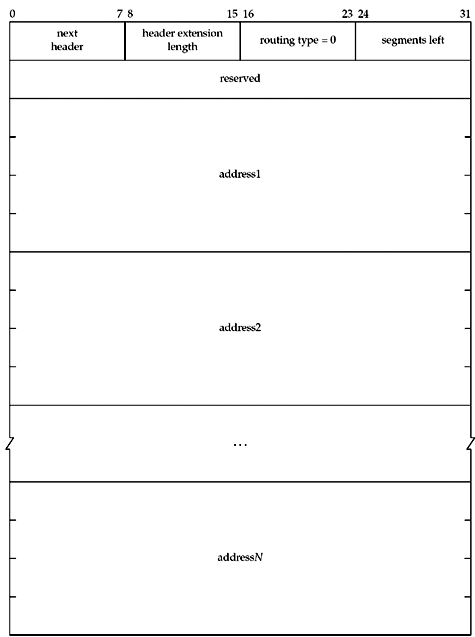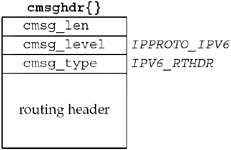27.6 IPv6 Routing Header
The IPv6 routing header is used for source
routing in IPv6. The first two bytes of the routing header are the
same as we showed in Figure 27.7: a
next header field followed by a
header extension length. The next
two bytes specify the routing type
and the number of segments left
(i.e., how many listed nodes are still to be visited). Only one
type of routing header is specified, type 0, and we show its format
in Figure 27.11.

An unlimited number of addresses can appear in
the routing header (limited only by packet length) and segments left must be equal to or less than
the number of addresses in the header. RFC 2460 [Deering and Hinden
1998] specifies the details of how the header is processed as the
packet travels to the final destination, along with a detailed
example.
The routing header is normally specified as
ancillary data with sendmsg and returned as ancillary data
by recvmsg. Nothing special needs to be done by the
application to send the header: just specify it as ancillary data
in a call to sendmsg. To receive the routing header, the
IPV6_RECVRTHDR socket option must be enabled, as in
const int on = 1;
setsockopt(sockfd, IPPROTO_IPV6, IPV6_RECVRTHDR, &on, sizeof(on));
Figure
27.12 shows the format of the ancillary data object used to
send and receive the routing header. Six functions are defined to
create and process the routing header. The following three
functions build an option to send:

|
#include <netinet/in.h>
|
|
socklen_t inet6_rth_space(int
type, int segments) ;
|
|
Returns: positive number of bytes if OK, 0 on
error
|
|
void *inet6_rth_init(void *rthbuf, socklen_t rthlen, int type, int segments);
|
|
Returns: non-null pointer if OK, NULL
on error
|
|
int inet6_rth_add(void *rthbuf, const struct in6_addr
*addr);
|
|
Returns: 0 if OK, -1 on error
|
inet6_rth_space returns the number of
bytes required to hold a routing header of the specified
type (normally specified as
IPV6_RTHDR_TYPE_0) with the specified number of
segments.
inet6_rth_init initializes the buffer
pointed to by rthbuf to contain a
routing header of the specified type and the specified number of segments. The return value is the pointer to
the buffer, and this pointer is then used as an argument to the
next function. inet6_rth_init returns NULL if an
error occurs, for instance, when the supplied buffer is not large
enough.
inet6_rth_add adds the IPv6 address
pointed to by addr to the end of the routing header being
constructed. When successful, the segleft member of the
routing header is updated to account for the new address.
The following three functions deal with a
received routing header:
|
#include <netinet/in.h>
|
|
int inet6_rth_reverse(const void
*in, void
*out);
|
|
Returns: 0 if OK, -1 on error
|
|
int inet6_rth_segments(const void
*rthbuf);
|
|
Returns: number of segments in routing header if
OK, -1 on error
|
|
struct in6_addr *inet6_rth_getaddr(const
void *rthbuf, int
index);
|
|
Returns: non-null pointer if OK, NULL
on error
|
inet6_rth_reverse takes a routing
header that was received (pointed to by in) and creates a new routing header (in the
buffer pointed to by out) that
sends datagrams along the reverse of that path. The reversal can
occur in place; that is, the in
and out pointers can point to the
same buffer.
inet6_rth_segments returns the number
of segments in the routing header described by rthbuf. When successful, the return value is
greater than zero.
inet6_rth_getaddr returns a pointer to
the IPv6 address specified by index in the routing header described by
rthbuf. index must have a value
between zero and one less than the value returned by
inet6_rth_segments, inclusive.
To demonstrate these options, we create a UDP
client and server. The client, shown in Figure 27.13, accepts a source route on the
command line like the IPv4 TCP client we showed in Figure
27.6; the server prints the received source route and reverses
it to send back to the client.
Create source route
11鈥?1
If more than one argument was supplied, all but the final argument
form the source route. We first determine how much space the route
header will require with inet6_rth_space, then allocate
the necessary space with malloc. We initialize the
allocated buffer with inet6_rth_init. Then, for each
address in the source route, we convert it to numeric form using
host_serv and add it to the source route using
inet6_rth_add. This is very similar to our IPv4 TCP
client, except that instead of our own helper functions, these
library functions are provided by the system.
Look up destination and create
socket
22鈥?3
We use host_serv to look up the destination, and create a
socket to use.
Set sticky IPV6_RTHDR option
and call worker function
24鈥?7
As we will see in Section 27.7,
instead of sending the same ancillary data with every packet, we
can use setsockopt to apply the routing header to every
packet in the session. We only set this option if ptr is
non-NULL, meaning that we allocated a route header earlier.
Finally, we call the worker function, dg_cli, which we
defined in Figure 8.8.
Figure 27.13
IPv6 UDP client with source route.
ipopts/udpcli01.c
1 #include "unp.h"
2 int
3 main(int argc, char **argv)
4 {
5 int c, sockfd, len = 0;
6 u_char *ptr = NULL;
7 void *rth;
8 struct addrinfo *ai;
9 if (argc < 2)
10 err_quit("usage: udpcli01 [ <hostname> ... ] <hostname>");
11 if (argc > 2) {
12 int i;
13 len = Inet6_rth_space(IPV6_RTHDR_TYPE_0, argc - 2);
14 ptr = Malloc(len);
15 Inet6_rth_init(ptr, len, IPV6_RTHDR_TYPE_0, argc - 2);
16 for (i = 1; i < argc - 1; i++) {
17 ai = Host_serv(argv[i], NULL, AF_INET6, 0);
18 Inet6_rth_add(ptr,
19 &((struct sockaddr_in6 *) ai->ai_addr)->sin6_addr);
20 }
21 }
22 ai = Host_serv(argv[argc - 1], SERV_PORT_STR, AF_INET6, SOCK_DGRAM);
23 sockfd = Socket(ai->ai_family, ai->ai_socktype, ai->ai_protocol);
24 if (ptr) {
25 Setsockopt (sockfd, IPPROTO_IPV6, IPV6_RTHDR, ptr, len);
26 free (ptr);
27 }
28 dg_cli (stdin, sockfd, ai->ai_addr, ai->ai_addrlen); /* do it all */
29 exit (0);
30 }
Our server is the same simple UDP server as
before: open a socket and call dg_echo. The setup is
trivial, so we do not show it. Instead, Figure 27.14 shows our dg_echo function,
which prints the source route if one was received and reverses it
for use in returning the packet.
Turn on IPV6_RECVRTHDR option
and set up msghdr struct
12鈥?3
To receive the incoming source route, we must set the
IPV6_RECVRTHDR socket option. We must also use
recvmsg, so we set up the unchanging fields of a
msghdr structure.
Set up modifiable fields and call
recvmsg
21鈥?4
We set the length fields to the appropriate sizes and call
recvmsg.
Figure 27.14
dg_echo function that prints and reverses IPv6 source
route.
ipopts/dgechoprintroute.c
1 #include "unp.h"
2 void
3 dg_echo(int sockfd, SA *pcliaddr, socklen_t clilen)
4 {
5 int n;
6 char mesg[MAXLINE];
7 int on;
8 char control[MAXLINE];
9 struct msghdr msg;
10 struct cmsghdr *cmsg;
11 struct iovec iov[1];
12 on = 1;
13 Setsockopt (sockfd, IPPROTO_IPV6, IPV6_RECVRTHDR, &on, sizeof(on));
14 bzero (&msg, sizeof(msg));
15 iov[0].iov_base = mesg;
16 msg.msg_name = pcliaddr;
17 msg.msg_iov = iov;
18 msg.msg_iovlen = 1;
19 msg.msg_control = control;
20 for ( ; ; ) {
21 msg.msg_namelen = clilen;
22 msg.msg_controllen = sizeof(control);
23 iov[0].iov_len = MAXLINE;
24 n = Recvmsg (sockfd, &msg, 0);
25 for (cmsg = CMSG_FIRSTHDR(&msg); cmsg != NULL;
26 cmsg = CMSG_NXTHDR (&msg, cmsg)) {
27 if (cmsg->cmsg_level == IPPROTO_IPV6 &&
28 cmsg->cmsg_type == IPV6_RTHDR) {
29 inet6_srcrt_print(CMSG_DATA(cmsg));
30 Inet6_rth_reverse(CMSG_DATA(cmsg), CMSG_DATA(cmsg));
31 }
32 }
33 iov[0].iov_len = n;
34 Sendmsg(sockfd, &msg, 0);
35 }
36 }
Find and process route header
25鈥?2
We loop through the ancillary data using CMSG_FIRSTHDR and
CMSG_NXTHDR. Even though we are only expecting one piece
of ancillary data, it is good practice to loop like this. If we do
find a routing header, we print it with our
inet6_srcrt_print function (Figure 27.15). We then reverse the route with
inet6_rth_reverse so that we can use it to return the
packet along the same path. In this case,
inet6_rth_reverse works on the route in place, so that we
can use the same ancillary data to send the return packet.
Echo packet
33鈥?4
We set the length of the data to send, and use sendmsg to
return the packet.
Figure 27.15
inet6_srcrt_print function: prints a received IPv6 source
route.
ipopts/sourceroute6.c
1 #include "unp.h"
2 void
3 inet6_srcrt_print(void *ptr)
4 {
5 int i, segments;
6 char str[INET6_ADDRSTRLEN];
7 segments = Inet6_rth_segments(ptr);
8 printf("received source route: ");
9 for (i = 0; i < segments; i++)
10 printf ("%s ", Inet_ntop(AF_INET6, Inet6_rth_getaddr(ptr, i),
11 str, sizeof(str)));
12 printf("\n");
13 }
Our inet6_srcrt_print is almost
trivial, thanks to the IPv6 route helper functions.
Determine number of segments in
route
7 We
first use inet6_rth_segments to determine the number of
segments present in the route.
Loop through each segment
9鈥?1
We loop through all the segments, calling
inet6_rth_getaddr for each one and converting the address
to presentation form using inet_ntop.
Our client and server that handle IPv6 source
routes do not need to know how the source route is formatted in the
packet. The library functions the API provides hide the details of
the packet format from us, yet give us all the flexibility we had
when we built the option from scratch in IPv4.

|